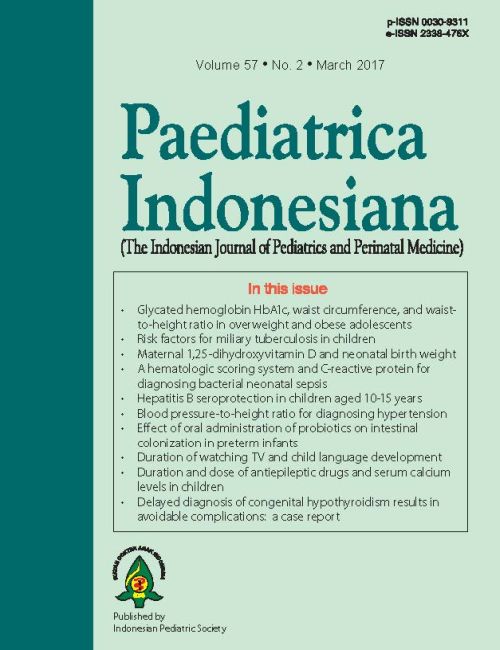Duration of watching TV and child language development in young children
Abstract
Background Many factors contribute to language development in children. About 5-8% of children in Indonesia experience delayed language skills. Young children need appropriate stimulation for optimal development. Children who watch television (TV) for long periods of time may receive less two-way interaction, the appropriate stimulation for learning. As such, shorter duration of the appropriate stimulation may impede language development in small children.
Objective To assess for an association between duration of watching TV and language development in young children.
Methods This cross-sectional study was done with primary data collected from questionnaires. Subjects, aged 18 months to 3 years, were from a Jakarta-area community health center (Puskesmas) Jatinegara and the Pediatric Growth and Development Clinic, Cipto Mangunkusumo Hospital, Jakarta. Their language development was tested using the Developmental Pre-screening Questionnaire (Kuesioner Pra Skrining Perkembangan, KPSP) and the Early Language Milestone (ELM Scale 2) test.
Results From a total of 84 subjects, 47 (56%) had normal and 37 (44%) had delayed language development. Duration of watching TV was categorized as <4 hours per day or >4 hours per day. Children who watched TV >4 hours/day (OR 4.4; 95%CI 1.68 to 11.7; P=0.002), and children who watched both Indonesian and English language TV programs (OR 14.7; 95%CI 1.77 to 123.0; P=0.004) had higher risk of language delay. Other variables such as sex, first age exposed to TV, use of gadgets, and TV in the bedroom had no significant associations with delayed language development.
Conclusion Children who watch TV >4 hours/day had four times higher risk of developing language delay. In addition, those who watch TV programs in both Indonesian and English, also have a 14.7 higher risk of delayed language development.
References
2. Council on Communications and Media, Brown A. Media use by children younger than 2 years. Pediatrics. 2011;128:1040-5.
3. Duch H, Fisher EM, Ensari I, Harrington A. Screen time use in children under 3 years old: a systematic review of correlates. Int J Behav Nutr Phys Act. 2013;10:102.
4. Tomopoulos S, Dreyer BP, Berkule S, Fierman AH, Brockmeyer C, Mendelsohn AL. Infant media exposure and toddler development. Arch Pediatr Adolesc Med. 2010;164:1105-11.
5. Soebadi A. Keterlambatan bicara [internet]. 2013; updated 12 June 2013; [cited 8 January 2015]. Available from: http://idai.or.id/public-articles/klinik/keluhan-anak/keterlambatan-bicara.html.
6. Suwarba IGN, Widodo DP, Handryastuti RAS. Profil klinis dan etiologi pasien keterlambatan perkembangan global di Rumah Sakit Cipto Mangunkusumo Jakarta. Sari Pediatri. 2008;10:255-61.
7. Ruangdaraganon N, Chuthapisith J, Mo-suwan L, Kriweradechachai S, Udomsubpayakul U, Choprapawon C. Television viewing in Thai infants and toddlers: impacts to language development and parental perceptions. BMC Pediatr. 2009;22;9:34.
8. Chonchaiya W, Pruksananonda C. Television viewing associates with delayed language development. Acta Paediatr. 2008;97:977-82.
9. Dhamayanti M. Kuesioner Pra Skrining Perkembangan (KPSP) anak. Sari Pediatri. 2006;8:9-15.
10. Walker D, Gugenheim S, Down MP, Northen JL. Early Language Milestone Scale and Language Screening of Young Children. Pediatr. 1989;83:284-8.
11. Biedinger N. The influence of education and home environment on the cognitive outcomes of preschool children in Germany. Child Dev Res. 2011;13:1-10.
12. Venetsanou F, Kambas A. Environmental factors affecting preschooler’s motor development. Early Childhood Educ J. 2009;37:319-27.
13. Ramirez NF, Lieberman AM, Mayberry RI. The initial stages of first-language acquisition begun in adolescence: when late looks early. J Child Lang. 2013;40:391-414.
14. Oxford M, Spieker S. Preschool language development among children of adolescent mothers. J Appl Dev Psychol. 2006;27:165-82.
15. Schmidt ME, Rich M, Rifas-Shiman SL, Oken E, Taveras EM. Television viewing in infancy and child cognition at 3 years of age in a US cohort. Pediatrics. 2009;123:370-5.
16. Jordan AB, Hersey JC, McDivitt JA, Heitzler CD. Reducing children’s television-viewing time: a qualitative study of parents and their children. Pediatrics. 2006;118:1303-10.
Authors who publish with this journal agree to the following terms:
Authors retain copyright and grant the journal right of first publication with the work simultaneously licensed under a Creative Commons Attribution License that allows others to share the work with an acknowledgement of the work's authorship and initial publication in this journal.
Authors are able to enter into separate, additional contractual arrangements for the non-exclusive distribution of the journal's published version of the work (e.g., post it to an institutional repository or publish it in a book), with an acknowledgement of its initial publication in this journal.
Accepted 2017-04-27
Published 2017-04-28













